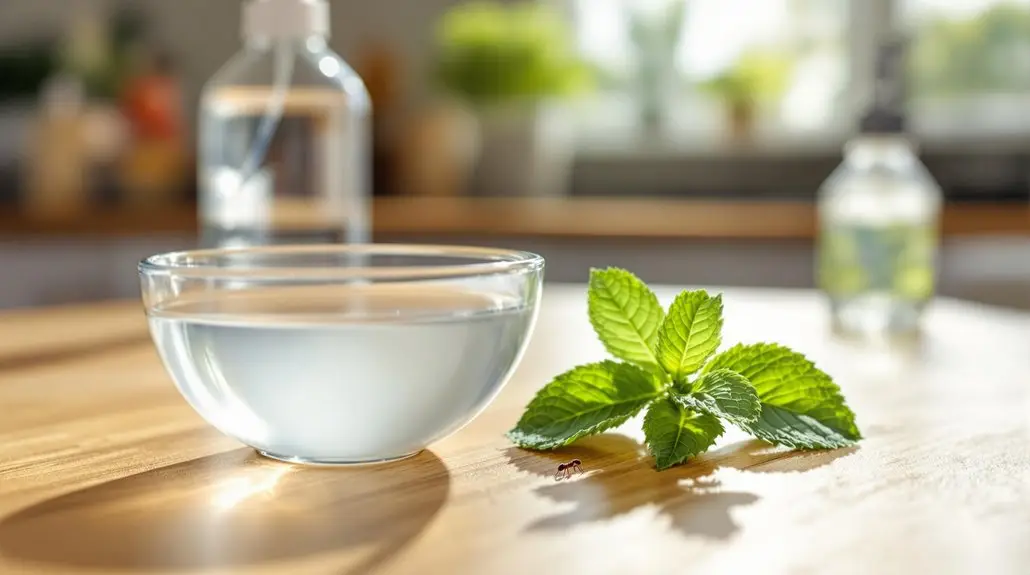Podcast: Play in new window | Download
Subscribe: Apple Podcasts | RSS
To effectively kill sugar ants naturally, start by eliminating food sources and keeping your kitchen clean. Create a vinegar solution by mixing equal parts water and vinegar, then spray it around entry points. Essential oils like peppermint and cinnamon can also repel ants when mixed with water. For a more targeted approach, use a bait of baking soda and powdered sugar or mix borax with jelly to lure and kill them. Keep an eye on their trails to adjust your strategy. Stick around for more tips on long-term prevention and effective natural remedies you can easily implement.
Key Insights
- Mix equal parts water and vinegar to create a natural repellent; spray around entry points and common ant paths.
- Combine borax with sugar and warm water to create an effective bait that attracts and kills sugar ants.
- Use a mixture of baking soda and powdered sugar to lure ants; the baking soda disrupts their digestive system.
- Sprinkle food-grade diatomaceous earth along ant trails to disrupt their paths and deter further activity.
- Utilize essential oils like peppermint or clove mixed with water as a natural deterrent around your home.
Eliminating Food Sources
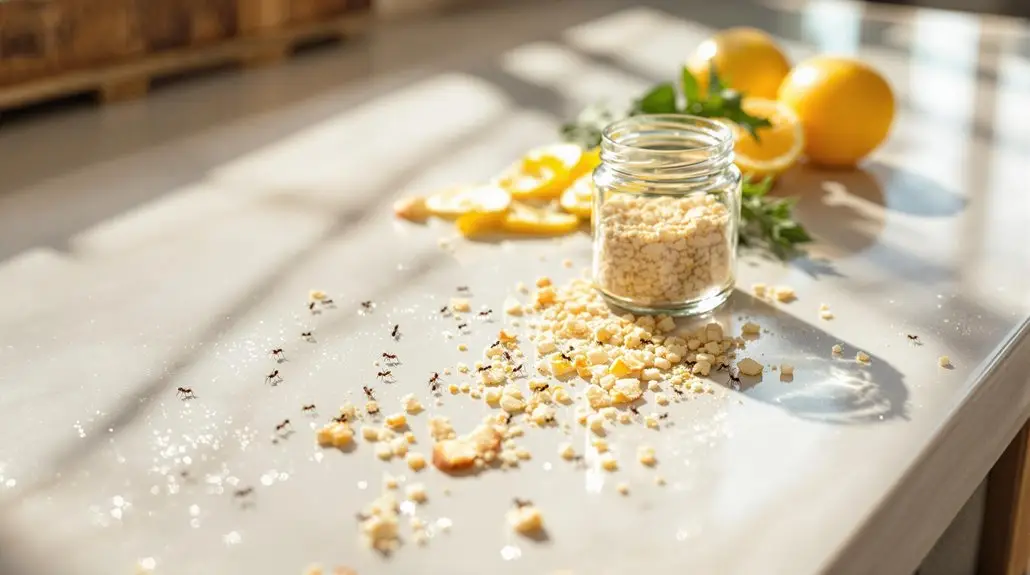
To effectively tackle sugar ants, the first step is eliminating their food sources. You’ll want to start by keeping your kitchen spotless. Make it a habit to wipe off sugary messes immediately after spills, and clean countertops and floors thoroughly after meals.
Store food in airtight containers to deny ants access, and don’t forget to remove and clean pet food bowls right after your furry friends finish eating. Guarantee all dishes are washed before you tuck them away, creating a clean slate for your kitchen. Additionally, consider implementing organic-compliant practices in your pest control efforts to ensure safety for your family and pets.
Next, focus on food storage and disposal. Keep sweet treats in sealed containers and dispose of garbage daily or every other day to minimize food odors. A clean garbage area is vital, so pay attention to the bottoms of bins and avoid leaving sticky substances on surfaces. Additionally, regularly cleaning surfaces helps to remove any food residues that could attract sugar ants.
When you have leftovers, transfer them to the fridge promptly to avoid attracting unwanted guests.
If you have pets, be vigilant about their food too. Don’t leave pet food out for long periods and clean up after them to eliminate crumbs and spills.
Store bird seed in sealed containers to prevent sugar ants from making a feast out of it, and keep pet areas tidy.
Lastly, consider your outdoor spaces. Avoid planting sweet potatoes or yams near entry points, and keep your garden clean.
Using White Vinegar
White vinegar is an effective and natural way to repel sugar ants, thanks to its strong smell that they can’t stand. Not only does it drive them away, but it also disrupts their communication by interfering with the pheromones they rely on. This humane pest control method doesn’t kill ants but simply encourages them to find a different path. Additionally, vinegar solutions can deter ants from entering homes, making it a practical choice for homeowners. Using integrated pest management strategies alongside vinegar can further enhance your pest control efforts.
Here’s a quick overview of how to use white vinegar effectively:
| Step | Instructions | Notes |
|---|---|---|
| Mix Solution | Combine equal parts of water and vinegar | For a stronger solution, use pure vinegar. |
| Application | Spray around entry points and common paths | Don’t forget countertops and cabinets! |
| Frequency | Reapply several times a week | The repellent effect wears off quickly. |
| Clean Up | Use vinegar to clean surfaces | This helps eliminate pheromone trails. |
To prepare your vinegar solution, simply mix it in a spray bottle and shake well. Apply it around windows, doors, and any areas where ants might enter your home. Regularly spraying the solution not only keeps ants at bay but also helps maintain a clean environment. Pairing vinegar with other natural repellents can enhance its effectiveness. With a little effort, you can create a welcoming space that’s free of sugar ants and filled with the comfort of knowing you’re using a secure, natural method.
Utilizing Essential Oils
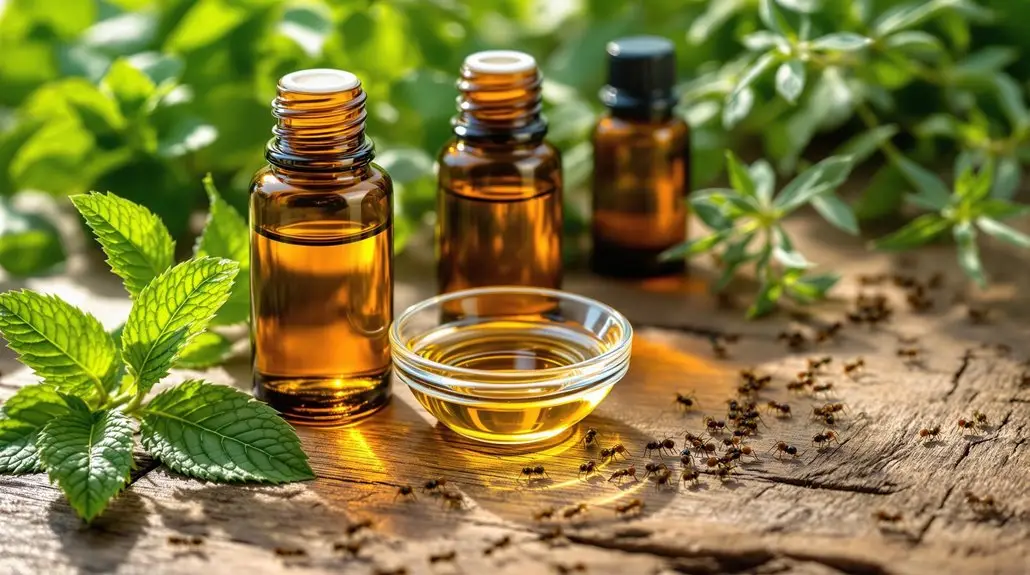
For those looking for another natural method to combat sugar ants, utilizing essential oils can be an effective solution. Oils like peppermint, clove, cinnamon, citronella, and lemon are known for their strong scents that ants simply can’t stand. Peppermint oil, for instance, not only repels ants but also leaves your space smelling fresh and invigorating. Clove oil, rich in eugenol, can actually kill ants on contact, while cinnamon oil has a spicy aroma that can choke and eliminate them. Citronella and lemon oils further distract ants from food trails, leading them away from your kitchen. Additionally, eucalyptus oil can create a barrier that prevents ants from entering your home, making it a valuable addition to your pest control arsenal. Many of these oils align with organic pest control methods that minimize chemical use.
To create your own essential oil ant spray, mix 30-40 drops of your chosen essential oil with 30 drops of alcohol and 60 ml of distilled water in a spray bottle. Shake well before using, and don’t hesitate to combine oils for a more potent mix. Spray around door frames, baseboards, and windows—places where ants often invade.
However, keep in mind a few precautionary measures. Some oils can be harmful to pets, so be cautious when spraying indoors. Avoid areas where bees may be foraging, and always cover fish tanks or pet dishes before application.
While essential oils can provide a temporary solution, you might need to reapply regularly, as they may not tackle the root issue of ant colonies. For long-term control, consider pairing these sprays with baits that target the entire colony.
Employing Natural Repellents
When you’re ready to tackle sugar ants, employing natural repellents can be a game changer. You can use effective ingredients like vinegar and lemon juice, and apply them in simple ways around your home. Exploring additional options like cucumber peels and essential oils will give you even more tools to keep these bothersome ants at bay. Utilizing natural and DIY methods can help eliminate ants without the need for exterminators.
Effective Natural Ingredients
Harnessing the power of nature, effective natural ingredients can be your best allies in repelling sugar ants. You can start with borax, mixing it with sweet substances like jelly or syrup. This slow-acting poison lures ants and helps dehydrate them, targeting their colony. Just remember to keep it out of reach of kids and pets! Additionally, common pests in Florida such as sugar ants can be effectively managed using these natural methods.
Boric acid works similarly, damaging ants’ nervous systems when mixed with sweet foods like peanut butter. This method can eliminate entire colonies, including the queen. Additionally, using eco-friendly pest control methods ensures a safer approach for your home.
Essential oils are another excellent option. Peppermint oil, for example, can be diluted with water and sprayed around entry points, while cinnamon oil offers a strong scent that deters ants. Lemon eucalyptus oil can be used on cotton balls placed in infested areas for extra effect.
In your kitchen, white vinegar mixed with water creates a powerful spray that kills ants on contact. You can also mix baking soda with powdered sugar to attract and eliminate them quickly.
Application Techniques
Effective natural ingredients can only go so far without the right application techniques. To keep sugar ants at bay, you’ll want to use essential oils and citrus infusions effectively.
Mix peppermint essential oil with water and spray it in ant-prone areas regularly. Lemon juice diluted with water can also work wonders when sprayed around ant trails and entry points. For a citrus infusion, simmer citrus peels in water, strain, and spray the solution where ants gather. Sugar ants are attracted to sweet food sources, so be sure to target areas where food is present.
You can employ vinegar and cleaning agents too. A 50/50 mixture of white vinegar and water can be sprayed directly on ants or into their holes, while cleaning surfaces with diluted vinegar repels them.
Don’t forget about powders and granules; sprinkling food-grade diatomaceous earth or talcum powder along ant trails can disrupt their path.
Lastly, traps and baits are essential. Mix boric acid with sugar and warm water, or create a baking soda and powdered sugar mixture to lure and kill ants.
Additional Repellent Options
Utilizing natural repellents can greatly enhance your battle against sugar ants. You’ll find that essential oils, like peppermint and tea tree oil, are excellent options. Just mix 10-20 drops with 2 cups of water and spray it around your home. Cinnamon oil and neem oil work similarly, providing strong scents that ants dislike. Sugar ants are often attracted to sugar substances, which makes these repellents especially effective in disrupting their foraging behavior.
Household items also serve as effective deterrents. Lemon juice can be placed in areas where ants gather, while cucumber peels are a surprisingly effective repellent. You can also use bay leaves or coffee grounds outside to keep ants at bay.
For a powdery approach, sprinkle talcum powder or ground cinnamon in infested areas. A mix of baking soda and powdered sugar can lure and eliminate ants, creating a sweet trap with deadly results.
Don’t forget about other natural options. A 50/50 vinegar and water solution can disrupt ant trails, while boiling water poured into their nests can provide immediate results.
Soap and water is another simple method to eliminate their scent trails. With these natural repellents, you’re well-equipped to reclaim your space from those annoying sugar ants!
Using Powders for Extermination
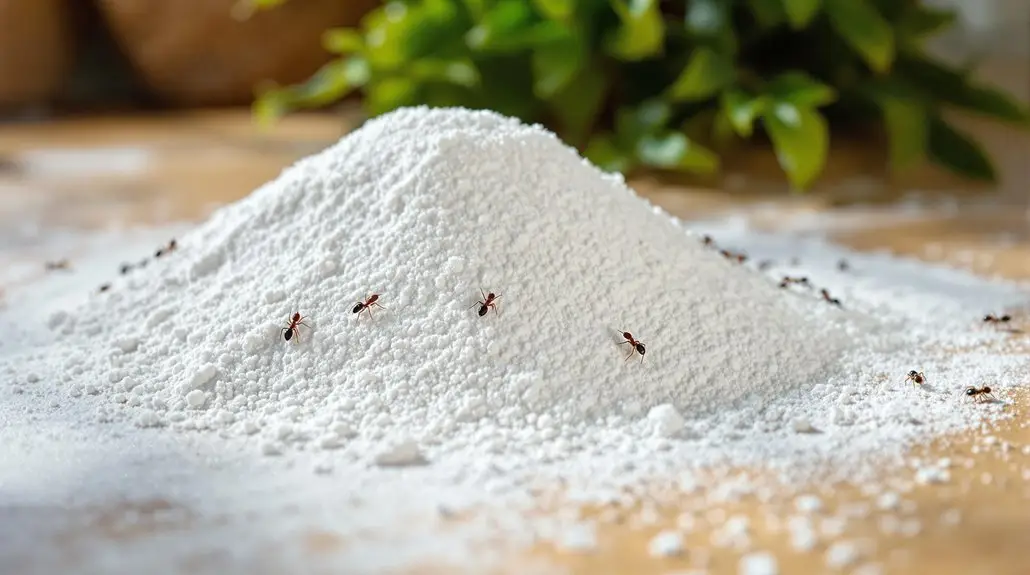
Another powerful powder is borax. By combining borax with a sweet substance like jelly or syrup, you create an enticing bait for the ants. The typical ratio is 3/4 teaspoon of borax with about 1/4 cup of the sweet substance. Set this mixture in shallow dishes or soaked cotton balls where ants are present. The beauty of borax lies in its slow-acting poison that allows ants to return to their colony, where they feed it to others, including the queen.
Diatomaceous earth is another option. This powder, made from fossilized diatoms, can be sprinkled around entry points. It works by causing irritation to ants’ membranes and can even suffocate them.
You can also use cornstarch, talcum powder, bay leaves, and pepper. While some of these serve more as deterrents than killers, they can help keep the ants at bay.
Whichever method you choose, using these powders is a natural way to reclaim your space from sugar ants while keeping your home secure for pets and kids.
Additional Methods
While powders can effectively target sugar ants, there are several additional methods that can help you manage and eliminate these pests. Using natural repellents, home remedy cleaners, and barriers can greatly enhance your efforts. Here’s a quick reference table to guide you:
| Method | Description |
|---|---|
| Essential Oils | Mix 10-20 drops of peppermint or tea tree oil with water and spray around. |
| Boiling Water | Pour boiling water into ant holes to kill ants instantly. |
| Cucumber Peels | Place fresh peels at entry points; replace when they dry out. |
You can also create a soapy water mixture to clean ant trails, making it harder for them to navigate your space. A 50/50 solution of white vinegar and water can deter ants and even kill them on contact. For a more natural approach, try using coffee grounds around infested areas; their smell can repel ants. Additionally, it is important to remember that sugar ants are known for scavenging sugar, which means keeping food sealed is crucial in preventing infestations.
Placing bay leaves in your pantry or nests can help eliminate colonies. If you want to attract and kill ants, mix baking soda with powdered sugar and sprinkle it around. Don’t overlook the importance of maintaining a dry environment, too; eliminating damp spots discourages ants from setting up shop. By incorporating these methods into your pest control strategy, you can create a less inviting space for sugar ants and foster a more comfortable home for yourself and your loved ones.
Importance of Cleanliness
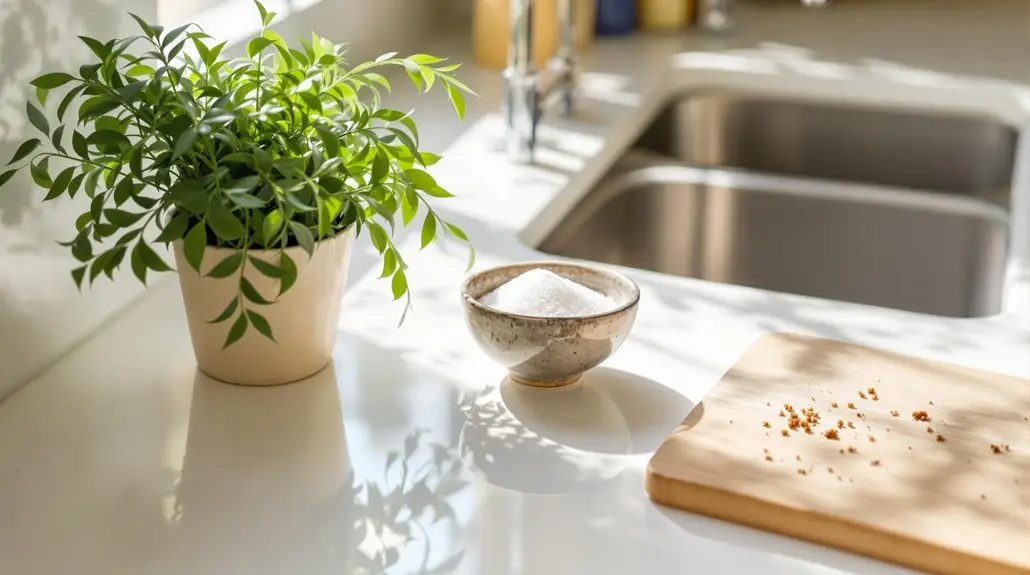
How essential is cleanliness in keeping sugar ants at bay? The answer is simple: it’s critical. Sugar ants are drawn to food residues, so by eliminating spills and crumbs right away, you’re cutting off their food supply.
Store your food in tightly sealed, airtight containers to guarantee they can’t access sugary snacks, honey jars, or sugar bowls. Regularly cleaning your pantry and storage areas helps maintain this barrier against pests.
Surface cleaning plays a huge role too. Wipe down your countertops and tables frequently with a mild detergent or a vinegar-water solution. This not only removes food residues but also disrupts any ant pheromone trails that might attract more ants.
Don’t forget those hard-to-reach spots under appliances where crumbs often hide. Regular sweeping and mopping in your kitchen will keep those troublesome particles from piling up. Furthermore, maintaining proper sanitation can reduce the likelihood of ants entering homes.
Moisture control is another essential aspect. Fix any leaky pipes and eliminate standing water around your home. Ants are always on the lookout for water sources, and by addressing these issues, you reduce their chances of finding a home in yours.
Lastly, sealing cracks and gaps around doors and windows creates a formidable barrier. By maintaining a high level of cleanliness, you can reduce ant infestations greatly.
Keep your yard clean too—removing debris and standing water can help deter ants from settling nearby. With these habits, you’ll create a welcoming environment for you and your loved ones, while keeping those sugar ants at a distance.
Identifying Sugar Ant Trails
Identifying sugar ant trails is essential for effectively managing an infestation, as these trails reveal the paths ants take to access food sources. When you spot lines of ants moving in and out of your home, it’s a clear sign that you need to act. Ants tend to follow the same path repeatedly, so tracking these trails can help you pinpoint where they’re entering and where their food sources are located.
You’ll often find these trails in places like your kitchen and pantry, where food is stored. Pay close attention to areas around appliances, such as your toaster oven, coffee pot, and refrigerator.
Bathrooms can also be hotspots, especially around sinks and countertops. Trails may even climb up surfaces like palm tree trunks to harvest honeydew.
Look for ants during their active hours, which are typically from dusk to dawn. They’re drawn to sweet, greasy, and fatty foods, and they leave pheromone trails for other ants to follow. If you see a trail, it’s likely indicating the presence of a food source, so take note of where these ants are heading.
Additionally, remember that different species of ants can have unique traits. For instance, odorous house ants give off a distinct smell when crushed, while pavement ants have specific features on their backs.
Understanding these clues can help you better combat the problem and reclaim your space.
Safe Practices Around Pets
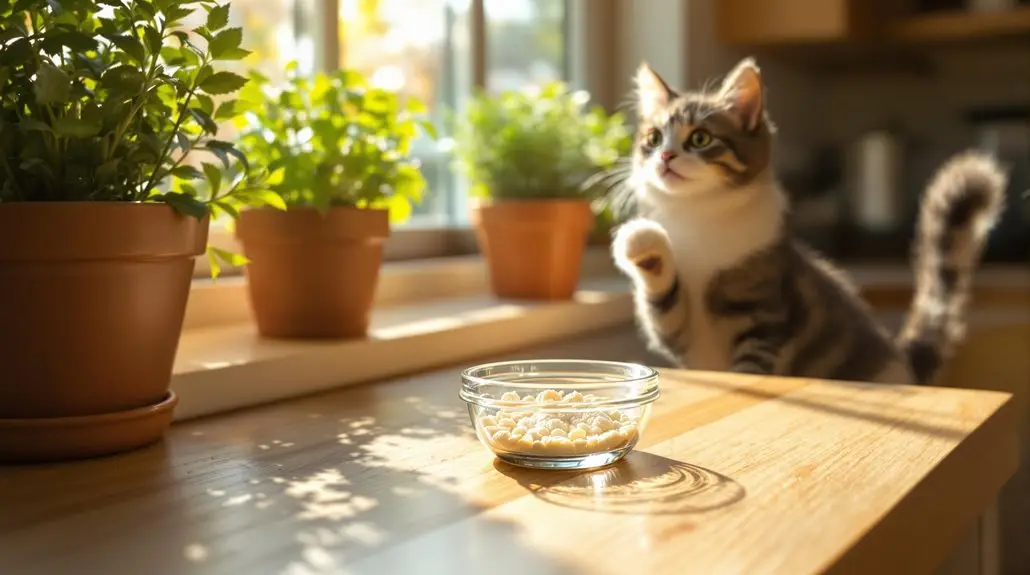
Once you’ve tracked sugar ant trails and pinpointed their entry points, it’s time to contemplate secure practices around your pets when dealing with these annoying invaders. You want to eliminate these pests without harming your furry friends. Non-toxic methods are your best bet.
Start with white vinegar. Mix it with water in a 50/50 solution to keep the smell manageable. Spray it directly on the ants or around areas where you’ve spotted them. It’s an effective repellent and disinfectant that leaves no toxic residues behind.
Essential oils can also work wonders. Peppermint, tea tree, neem, and cinnamon oils are reliable alternatives. Dilute 10-20 drops in two cups of water and spray it around your home, focusing on entry points. Just be sure to avoid any undiluted contact with your pets to prevent irritation.
Another simple method is using coffee grounds. Sprinkle them around the affected areas (but avoid indoors to prevent stains). The smell of coffee naturally deters ants and is completely harmless for your pets.
Long-Term Prevention Strategies
To effectively keep sugar ants at bay in the long run, focus on a combination of sealing entry points, maintaining cleanliness, and eliminating food and water sources.
By adopting these strategies, you’ll create an environment that’s less inviting to these bothersome invaders.
Here are three key steps to follow:
1. Seal Entry Points: Identify and seal all cracks and crevices around windows, doors, and utility lines.
Use caulk or silicone sealant for gaps and install door sweeps to block those sneaky entrances.
Don’t forget to repair any damaged screens.
2. Maintain Cleanliness: Keep your kitchen and dining areas spotless.
Wipe down countertops, sinks, and floors regularly to remove crumbs and spills.
Wash dishes immediately after meals and store food in airtight containers to avoid attracting ants.
3. Eliminate Food and Water Sources: Store sweet foods away from easy access and make sure pet food isn’t left out for too long.
Fix any leaks and dry damp areas to eliminate water sources, making your home less appealing to sugar ants.
DIY Natural Ant Baits
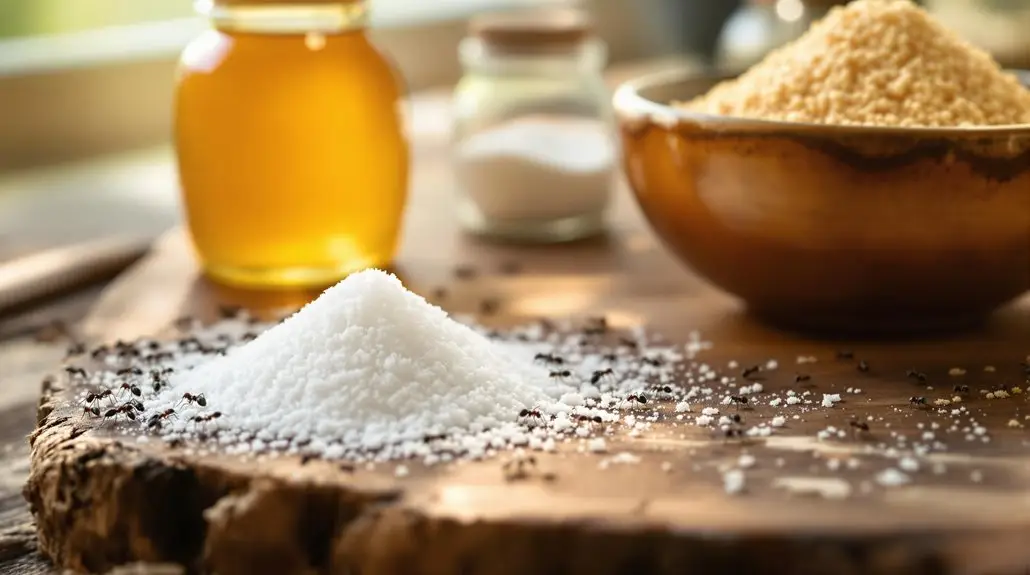
When you’re ready to tackle sugar ants, creating DIY natural ant baits is a smart move.
You can use effective ingredient combinations like borax and sugar or baking soda and powdered sugar to lure them in.
Just remember to place your baits in areas where you’ve spotted ant activity for the best results. Additionally, consider utilizing pest control services to address any ongoing ant issues effectively.
Effective Ingredient Combinations
Creating effective DIY natural ant baits can be a game changer in your battle against sugar ants.
By using simple ingredients you likely already have at home, you can create powerful combinations that attract and eliminate these troublesome pests.
Here are three ingredient combinations that really work:
- Borax and Sugar: Mix equal parts of borax and a sweet substance like jelly or syrup. This paste lures the ants, and when they take it back to the nest, it kills the colony.
- Baking Soda and Powdered Sugar: Combine baking soda with powdered sugar to create a chalky mixture. The sweet smell draws ants in, while the baking soda does the dirty work of eliminating them.
- Boric Acid and Sweet Substances: Dissolve boric acid in warm water with sugar and use it to saturate cotton balls. Place these where you see ants, and it’ll eventually take out the queen and her colony.
Placement Strategies for Baits
Effective placement of DIY natural ant baits can greatly enhance your efforts to eliminate sugar ants. Start by identifying entry points and following trails. Place baits near doorways, windowsills, and obvious ant paths, especially in kitchens and around pet food areas. Position them where sugar and sweet substances are found, like countertops and garbage bins.
Here’s a quick reference table to guide your placement strategy:
| Location Type | Specific Areas | Notes |
|---|---|---|
| Entry Points | Doorways, windowsills | Focus on cracks and gaps |
| Food Sources | Kitchen counters, pantries | Clean spills to reduce attraction |
| Water Sources | Sinks, pet bowls | Ants are drawn to moisture |
| Outdoor Areas | Bird feeders, near plants | Check regularly for new trails |
Combine baits with natural repellents like essential oils or herbs for added effectiveness. Remember to regularly check and replenish your baits, ensuring they remain effective and out of reach of pets and children. By following these strategies, you’ll foster a sense of accomplishment within your home, creating a space where sugar ants are no longer welcome.
Monitoring Ant Activity
To successfully manage a sugar ant problem, monitoring their activity is crucial. By keeping a close eye on their movements, you can take proactive steps to prevent larger infestations. Here’s how to effectively monitor sugar ants in your home:
1. Identify Entry Points: Regularly inspect your home’s perimeter for cracks and crevices around doors, windows, and pipes. Seal these openings with caulk or weatherstripping to block ant entry.
Use a flashlight to check dark areas for trails that can indicate common routes.
2. Track Ant Trails: Ants follow pheromone trails, so observing their movement can help you trace their paths. Use soapy water or vinegar to clean these trails, disrupting their signals.
You can also use sticky tape or cardboard to capture ants and study their patterns, leading you to the source of the problem.
3. Observe Food and Water Sources: Sugar ants are attracted to sugary substances and food crumbs. Confirm your dishes are washed and surfaces wiped down.
Keep food sealed in containers and regularly dispose of garbage. Pay attention to pet food and any damp spots that may attract them.
Frequently Asked Questions
What Are the Main Differences Between Sugar Ants and Other Ant Species?
When you compare sugar ants to other ant species, you’ll notice several key differences.
Sugar ants are small, typically between 2 to 15 mm, and have a segmented body. They thrive in warm, humid environments, often nesting indoors near food.
Unlike fire ants, they aren’t aggressive and rely on sugary substances for food. Their colonies may have multiple queens, allowing them to grow quickly, while their nocturnal foraging habits set them apart from many other ants.
How Can I Prevent Sugar Ants From Entering My Home?
To prevent sugar ants from entering your home, keep your kitchen spotless.
You’ll want to wipe down surfaces and store food in airtight containers.
Regularly take out the trash and clean up pet dishes right after meals.
Seal any entry points with natural barriers like bay leaves or citrus peels.
Creating a clutter-free environment will also help, as it reduces hiding spots.
Taking these steps together creates a welcoming space for you, not ants.
Are There Specific Times of Year When Sugar Ants Are More Active?
When it comes to sugar ants, think of them as tiny ninjas, stealthily invading your space.
They’re most active during warmer months, especially from late February to early fall.
If it gets unusually hot and dry, their activity might stretch even longer.
Keep an eye out, as they tend to forage at night, making it essential for you to stay vigilant during these peak seasons to keep your home ant-free.
How Long Does It Take for Natural Methods to Eliminate Sugar Ants?
When you’re tackling sugar ants, the time it takes to eliminate them varies by method.
For instance, vinegar solutions work quickly but might need daily applications. Borax and sugar baits can take up to three weeks as ants bring the bait back to the nest.
Diatomaceous earth kills within days, while essential oils require regular reapplication.
Staying consistent with your chosen method is key to achieving a pest-free space you can enjoy.
Can Sugar Ants Cause Any Damage to My Home or Property?
Imagine walking into your kitchen, only to spot a trail of tiny sugar ants marching across your countertop.
While they won’t cause structural damage, their presence can lead to food contamination and cleanliness issues, making you feel uneasy in your own home.
Plus, they might attract other pests, turning a minor nuisance into a bigger problem.
Keeping an eye on these little invaders helps maintain a comfortable and welcoming space for you and your family.
Outsmart Sugar Ants Naturally: Partner with NaturePest Holistic Pest Control Today!
By combining these natural methods, you can wage a successful war against sugar ants without resorting to harsh chemicals. It’s like playing a game of chess—strategically outsmarting your tiny foes while keeping your home secure. Remember to monitor their activity and adapt your tactics as needed, just like a detective piecing together clues. With patience and persistence, you’ll reclaim your space and enjoy sweet success in keeping those troublesome ants at bay!
For a more comprehensive approach to pest control, consider partnering with NaturePest Holistic Pest Control. Our expert team specializes in natural methods that effectively eliminate sugar ants while ensuring the safety of your home and family. Don’t let sugar ants invade your space—contact us today and take the first step towards a pest-free environment!

